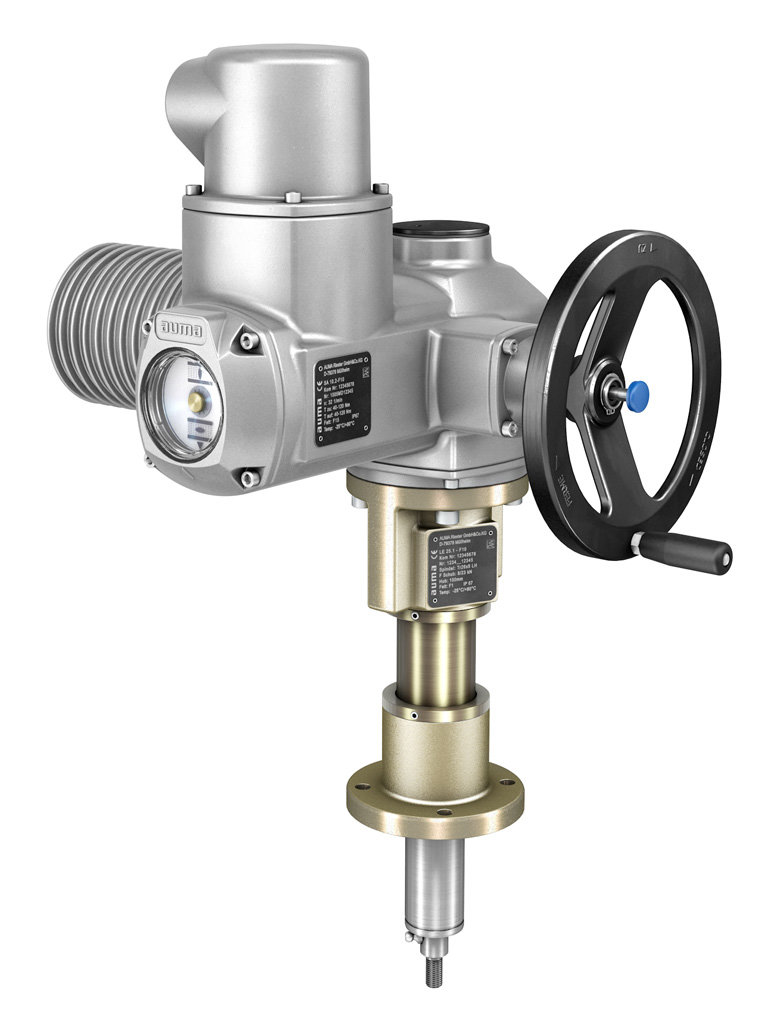Auma
Actuators SA and SAR
Actuators of the SA type range for open-close duty and positioning duty are rated for class A and B or types of duty S2 – 15 min. A special version for longer running is available for the S2 – 30 min duty.
The modulating actuators of the SAR range are rated for class C or types of duty S4 – 25 %. Special versions for S4 – 50 % and S5 – 25 % are also available.
Actuators of type range SA/SAR 07.2 – SA/SAR 16.2 can be combined with various controls from simple OPEN-CLOSE control to the micro-controlled version with logging of operating data or fieldbus interface.
Details
Design features SA
Torque range from 10 Nm to 32,000 Nm
Output speeds from 4 to 180 rpm
Limit and torque sensing
Available with 3-ph AC, 1-ph AC and DC motors
Handwheel for manual operation
Design features SAR
Torque range from 15 Nm to 4,000 Nm
Modulating torque range from 15 Nm to 1,600 Nm
Max. number of starts 1,200 c/h
Output speeds from 4 to 90 rpm
Available with 3-ph AC, 1-ph AC motors
Ambient conditions
High enclosure protection
High quality corrosion protection
Wide ambient temperature ranges
Options
Intermediate position switches
Switches in tandem version
Remote position transmitter
Magnetic limit and torque Transmitter
Mechanical position indicator
Functional safety: Up to SIL 2 in selected configurations
Interfaces
Electrical connection via AUMA plug/socket connector (optionally terminals)
Cable entries in different versions
Output drive types according to ISO and DIN Standards
Combinations with worm gearboxes
By combining the multi-turn actuators SA with the worm gearboxes GS, they are turned into electric part-turn actuators for higher torque requirements. These combinations supplement the part-turn actuator ranges SQ whose torque ranges are limited to 2,400 Nm.
Design features
Torque range from 250 Nm to 675,000 Nm
Swing angles up to 100°
Operating times for 90 ° from 9 s to 392 s
adjustable end stops
self-retaining
Swing angles > 100° or multi-turn
(without end stops)
Electrical connection via AUMA plug/ socket connector (optionally terminals)
Plug cover with threads for cable glands
Output drive types according to ISO and DIN standard
Combinations with linear thrust units
To perfom linear movements, e. g. in case of globe valves, the multi-turn actuator SA can be combined with the linear thrust unit LE. In case a lever arrangement has to be operated, the linear thrust unit can be mounted on a base.
Thrusts from 4 kN to 217 kN
Strokes from 50 mm up to 500 mm
Speeds from 20 mm/min to 360 mm/min
Actuators SGC and SGCR
The “small” electric part-turn actuator range with integral controls.
All parameters are directly set at the actuator.
The controls contain switchgears, power supply unit, interface to the DCS. The component automatically switches the actuator off, once the valve end position is reached, motor overheating is detected or a torque overload has occurred.
All housing parts are made of aluminium. For this reason, the actuators are lightweight devices.
The actuators SGC are rated for class A and B or types of duty S2 – 15 min, the actuators SGCR for class C or types of duty S4 – 40%.
Documents
Design features SGC and SGCR
Torque range from 25 Nm to 1000 Nm
Swing angles 82 ° to 98 °
Operating times for 90° from 4 s to 90 s
Output speeds from 0.6 to 22 rpm
Max. 16 turns per stroke
Limit and torque seating
Variable speed, brushless Motor
Position feedback signal 4 … 20 mA or
via fieldbus interface
High shock resistance
Local controls mounted separately from the actuator
Control inputs with different voltages (DC/AC)
Potential-free signal relays for status indication
Fieldbus Interface
Actuators SGM and SGMR
The “small” electric part-turn actuator range with integral controls.
All housing components are made of bronze, all external screws are made of stainless steel. This ensures complete resistance against sea water even over a longer time period.
The actuators SGM are rated for class A and B or types of duty S2 – 15 min, the actuators SGMR for class C or types of duty S4 – 40%.
Design features SGM and SGMR
Position feedback signal 4 … 20 mA or via fieldbus interface




